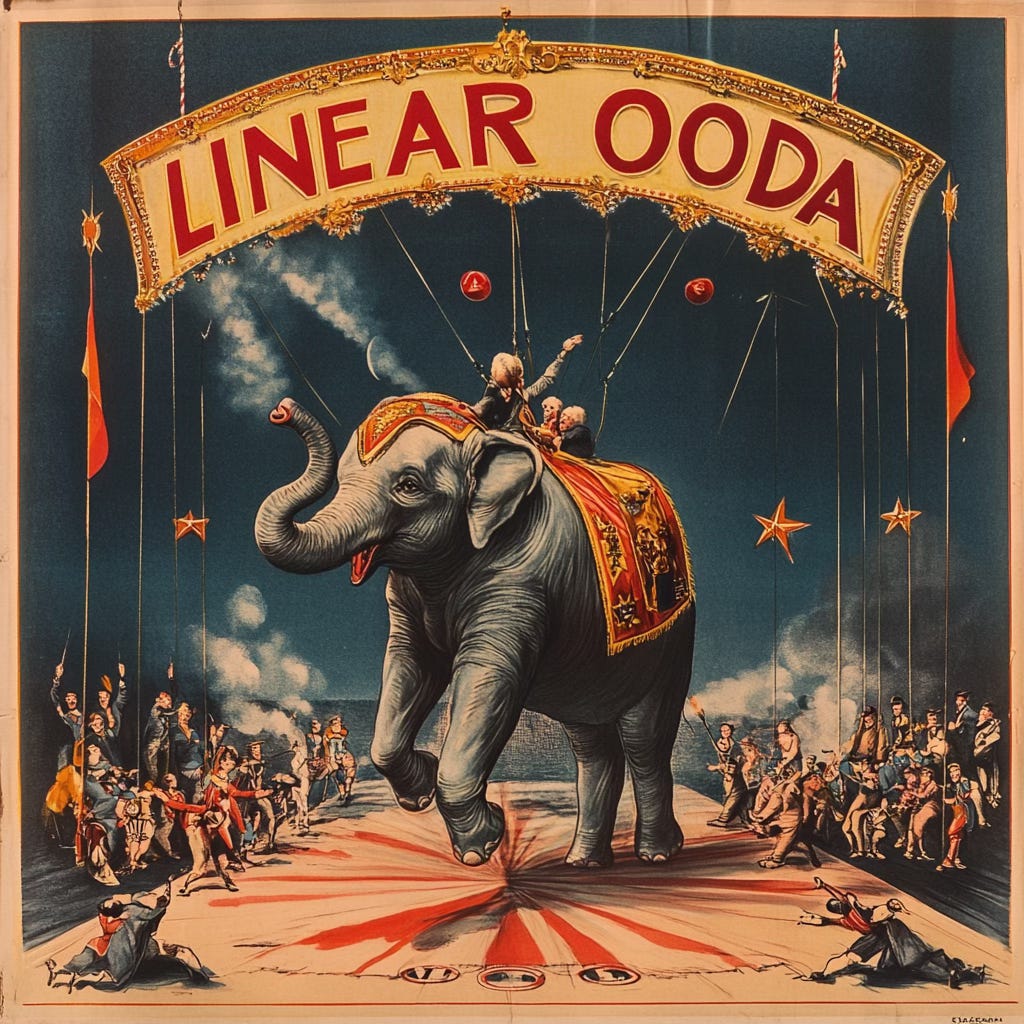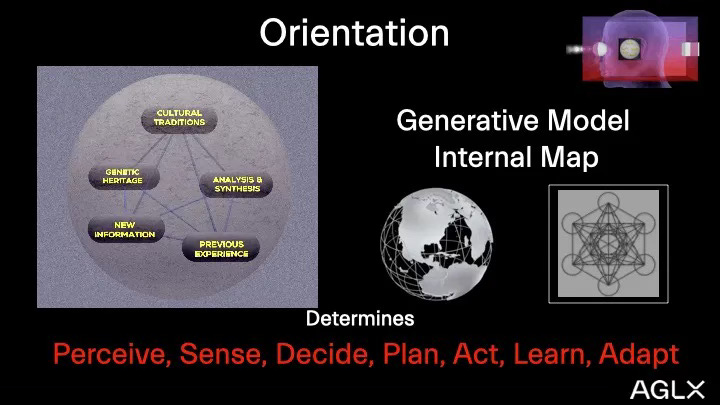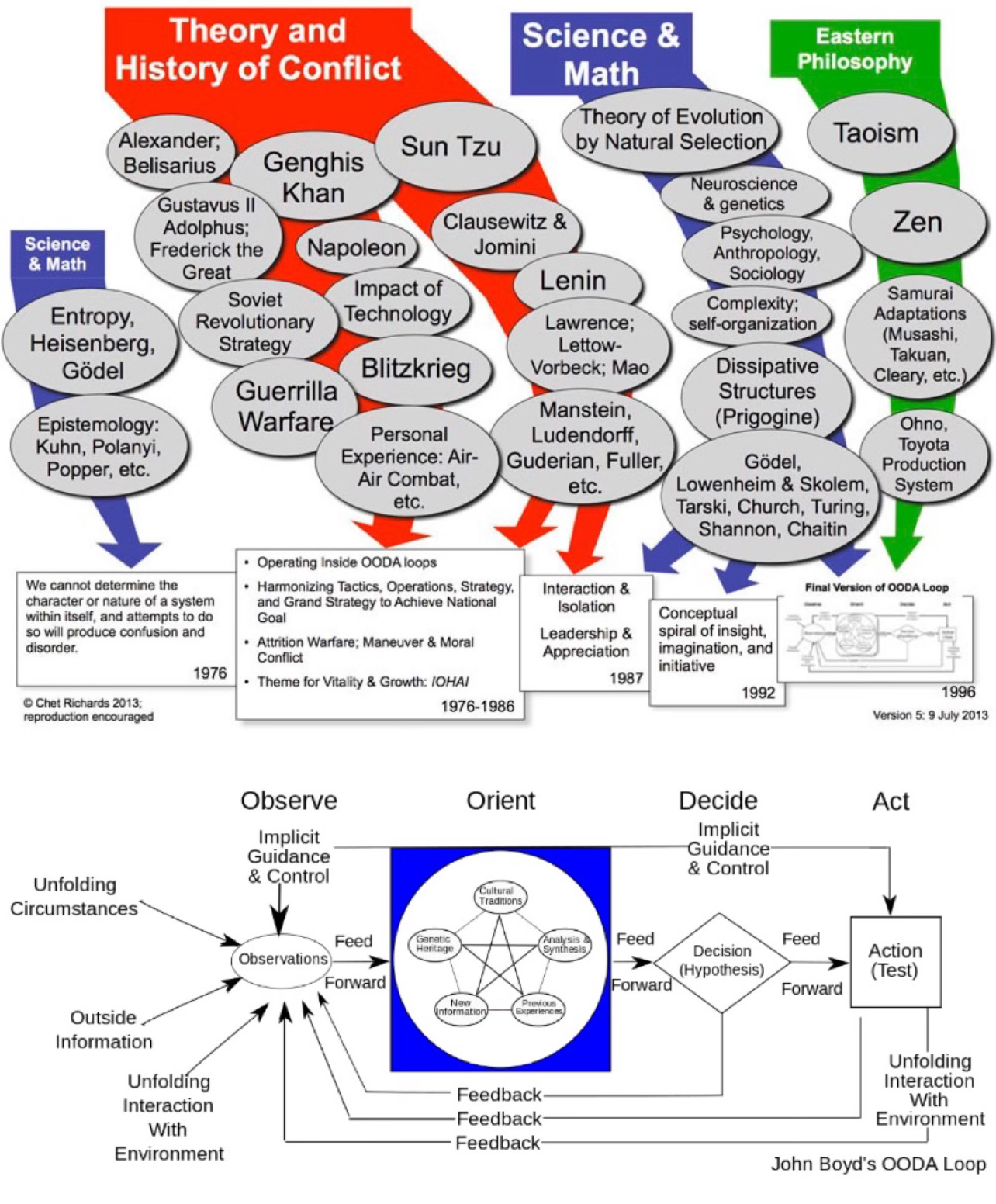Seemingly Simplified "Solutions" Sabotage Success
The consultant-approved "Linear OODA loop" is wrong, costly and sabotages success. A Boyd Acolyte shows us how to actually win with the Real OODA "loop."
John Boyd’s OODA "loop" is misunderstood by most, including many consultants. If you think it’s a simple cycle—observe, orient, decide, act—you’ve been sold a bill of goods and are on the road to defeat. The real OODA "loop" is not linear, and it’s not learned from consultants on stage in a one hour show. To compete to win, you must understand the real depth behind Boyd’s thinking, and this requires work, an open mind and a genuine will to improve your capacity for free and independent action.
Let me suggest a resource to get you started on separating yourself from competitors that operate on Linear OODA.
Since the 1970s, Chet Richards has spent years working with, studying, and teaching Boyd. He was a close personal friend of Boyd and should be very familiar to many in our audience. He was a guest on No Way Out and is a tremendous mentor, teacher, and collaborator.
Chet has a great paper that helps leaders and their teams avoid the imminent failure that comes with learning and institutionalizing Linear OODA. The title of this classic paper is Boyd’s Real OODA Loop. In this concise and to the point work, Chet shows us how to unlock the power of Boyd’s ideas. Remember: this is paper is from the mind of a close personal friend and decades long collaborator of John Boyd.
I am absolutely recommending that you read and re-read Chet’s paper. It’s insights can help you avoid the high fees of consultants that preach Linear OODA, and the costs of its imminent failure.
The Real OODA "Loop"
• Orientation Is the Key
This emphasis on orientation implies that every conflict, whether business, war, the martial arts, sports, politics or whatever, contains an embedded learning contest of keeping orientations accurate so that we can make better predictions of the effects of our actions than the predictions of our opponents or competitors (Boyd, 1976). But success under this model is not a simple, accumulative process, where one gradually adds to one’s net competitive advantage account and the side with the higher balance wins. Instead, by maintaining better awareness, one can create opportunities to act.1
Orientation is the heart of Boyd’s "loop." It is not a mere "step" or "phase." It’s who you are. It's how you process information, shape decisions, act, learn, and adapt. Your orientation always evolves. It is always adjusting to the feedback you get from unfolding circumstances in your environment. It’s not a simple stage in a linear process—it drives everything. EVERYTHING. If you don’t understand this, you’re missing the point. And if you don't and your competitors do, you won't be around long.
• Implicit Guidance and Control
Trying to employ cheng / ch’i maneuvers via the circular OODA loop does not work well when one is engaged with an opponent. The need to go through stages before coming around to action is too slow and too easy to disrupt (Klein, 1999). If, on the other hand, action can flow rapidly from orientation directly via an implicit guidance and control (IG&C) link, then any pattern of actions becomes possible. As Boyd (1987a) put it, “The key idea is to emphasize implicit over explicit in order to gain a favorable mismatch in friction and time (i.e, ours lower than any adversary’s) for superiority in shaping and adapting to circumstances” (p. 22). This explains the two implicit guidance and control links in Figure 2 [OODA “loop” sketch], as contrasted with none in Figure 1 [the simplified four step “OODA Loop”].2
Boyd stressed "implicit guidance and control." It is how you shape what you see and sense. It is also how you can act reflexively when need be. It’s acting instinctively without cycling through a linear decision-making process. Your best people and teams don’t need orders—they act based on their understanding of what needs to be done. This is what makes great organizations fast and adaptable. Understanding "implicit guidance and control" will likely be the biggest differentiator.
• Speed Isn’t Everything
So always acting at a faster tempo, while often extremely useful, is not a good general principle for success in competitions. Boyd hinted at this when he, sort of, defined “operating inside the OODA loop,” on chart 132 of Patterns of Conflict. In that chart, he passed on the opportunity to describe it simply as “more quickly” but also added "more inconspicuously,” and “with more irregularity.”
People think Boyd’s OODA "loop" is about speed—cycling through it faster than your competitor. That’s a dangerous and costly myth. Success comes from having an orientation that always adjusts to bring perception as close to reality as possible. Once you understand the situation better than your competitors, acting with speed is a natural result. However, the focus should always be on direction, creating friction for competitors and putting them in situtaions they cannot handle. Not speed alone.
• Collaboration, Creativity, Competitiveness
Successful organizations exploit the creativity and initiative found within their members, but they harmonize them to accomplish common objectives. This is not as easy as it seems. Rigidly enforced organizational dogma, for example, can produce a type of harmony, but it rarely encourages initiative. There is a way, however, to break the trade-off and achieve both harmony and initiative. Boyd (1986) asserted that “Without a common outlook superiors cannot give subordinates freedom-of-action and maintain coherency of ongoing action.” In this view, “A common outlook … represents a unifying theme that can be used to simultaneously encourage subordinate initiative yet realize superior intent” (p. 74). Research is confirming this: Espevik, Johnson, Eid, and Thayer (2006), for example, found that when members of a group share mental models of the situation, typically by keeping the group intact during training and operations, their performance can be sustained even under conditions of stress.3
The real OODA “loop” is about more than reacting, aimlessly and uncoordinated. It is about creativity, collaboration, and competitiveness. Teams with a shared orientation can adapt faster than competitors mired in self-inflicted rigidity, bureaucracy and “doing what everyone else is doing.” That’s why understanding Boyd’s real OODA "loop" gives you an edge in any competitive field. Taking the initiative, leading, and setting the pace is an edge. Teams become autonomous and proactive in driving towards goals. Reacting, on the other hand, is playing catch-up. Let your competition do that.
• Inside the Opponent’s "Loop"
These concepts go considerably deeper than cycling through “observe, then orient, then decide, then act” more rapidly than an opponent. He made the claim that the ability to operate inside O-O-D-A loops, rather than just cycle through them more quickly, enabled one to execute an agenda of heinous acts upon one’s adversary, culminating in “Generate uncertainty, confusion, disorder, panic, chaos … to shatter cohesion, produce paralysis and bring about collapse” (Boyd, 1986, p. 132).4
We discussed that Boyd’s real insight wasn’t about speed but about operating inside your opponent’s loop. What does that really mean? That means changing the environment so fast that your competitor can’t keep up. That means throwing them into situations and conundrums that they cannot solve, shattering their cohesion and correspondence with reality. This applies to business, sports, and capital markets, too. Whether launching products, playing in the Super Bowl, or adjusting to market changes, get ahead by staying ahead.
Avoid the Linear Trap
As beguiling as this simple concept might be, it is not a powerful weapon of strategy, either in war or for business. There are several reasons for this possibly counterintuitive result:
• The most important is that a simple, sequential loop does not well model how organizations act in a conflict.5
Most consultants get Boyd dead wrong. They sell a simplistic version of the OODA "loop," peddling it in corporate theater. They pitch a simple four-step process, "a tool that fighter pilots use," that makes you “faster.” They reduce it to a templated linear heuristic that you can pin on a bulletin board and "use in certain situations." Don't fall into this fatal trap. These engagements might be fun, but they won’t teach you and your team to win. You will not be left with insight that you can immediately build an internal component around. A linear view of the OODA "loop"—observe, then orient, then decide, then act—can lead to failure and catastrophe. Ask Blockbuster. Ask Kodak. Things in the real world are not linear and symmetric. They are always volatile, uncertain, complex, and ambiguous (VUCA). A linear understanding of the OODA "loop" leaves you vulnerable to competitors who understand its true complexity.
The Bottom Line
OODA loops or “loops” — and any will do so long as they accomplish the processes shown in the OODA “loop” sketch — create and employ implicit repertoire. OODA loops are your factory for building snowmobiles. Think of them like a NASCAR racing team: They build the cars, race them, and improve them from week to week. Along the way, OODA loops also refine our orientations, our mental models for how the world works, the most important aspect of which is our ability to accurately predict the results of our potential actions.6
Boyd’s work is an illustrative abstraction for navigating chaos and winning in any competitive environment. It was left open and incomplete intentionally so the work could always evolve. You must understand this and get it right. Chet Richards’ paper, Boyd’s Real OODA Loop, is essential reading. It helps to strip away the myths and reveals the true depth and broad applicability of Boyd’s thinking. This will create immediate, real value.
If you want to stay ahead—if you want to lead, create, and compete—then take the time to study Boyd’s real OODA "loop." Read Chet’s paper many times. Listen to our conversation with him on No Way Out. And be ready for more as we continue to explore Boyd’s ideas for future projects together.
Get Boyd's real OODA "loop" right, or your competitors will attack this vulnerable gap.
It’s that simple.
Richards, Chet. Boyd’s Real OODA Loop. Slightly East of New, 2018, https://slightlyeastofnew.com/wp-content/uploads/2018/05/boyds-real-ooda-loopx.pdf. Accessed 17 Oct. 2024.
Ibid.
Ibid.
Ibid.
Ibid.
Ibid. This is one of my favorite summaries. Thank you Chet!









